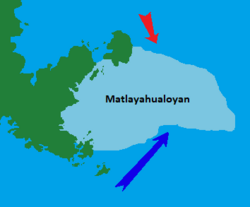Matlayahualoyan
Matlayahualoyan (lit. "Place where fish are encircled with nets") is an ocean bank off the east coast of Zacapican off the coasts of the Anamictlan consisting of a series of seamounts, tablemounts and other submerged geological formations on the Oxidental continental shelf. It is a rich and economically significant fishing ground supporting sardine, anchovy, herring as well as tuna and several species of billfish such as swordfish and sailfish among others. The wealth of this fishery is due to its geology and location, as the cold Cecatoya current (also known as the Outer Amictlan current), an offshoot of the Austral Circumpolar current meets the shallow waters and steep landforms of the Matlayahualoyan oceanic region, lifting nutrient rich water up from the deep ocean where it mingles with the warm West Course current which flows along the western Ooreqapi ocean south from the Equator. These conditions create an ideal breeding ground for many species of pelagic fish, and are also responsible for the notoriously foggy weather patterns of the region.
Geography
History
The underwater landforms of the Matlayahualoyan are believed to be relatively young, with origins some 20,000 years ago according to Zacapine geologists. Much of the coastline is believed to have been formed through glacial erosion ending in this period, carving out a number of islands, inlets, coves, bays and shallow lagoons which would later become important breeding grounds for marine life. The abundance of fish, seals and crabs in these shores sustained the indigenous people of southern Zacapican, including the Iakan of Anamictlan and the Ona of eastern Aztaco and Mixincayoco. It was also this richness of the southeastern shores of Zacapican that would draw the migratory Nahuas from their diaspora across the southern reaches of the continent, as well as the colonial Purépecha who would arrive later. It was indeed the Purépecha with their advanced shipbuilding and navigation techniques that revolutionized the Matlayahualoyan and enabled much more effective exploitation of the fish stocks there, which would later fuel the growth of the grand medieval urban centers of eastern Zacapican through the rise and the peak of the Aztapamatlan republic and its expanding hegemony between the year 900 and 1600. The Matlayahualoyan fisheries became economically vital to Aztapamatlan, especially its capital city Angatahuaca, to the extent that unusual oceanic conditions could lead to major upheaval and unrest in the city with rippling effects across the republic.
Serious upheaval would not come until the modern era, however, with the advent of industrial fishing vessels, factory ships, and sonar navigation. These innovations of the mid 20th century led to a case of serious and sustained overfishing of the Matlayahualoyan which collapsed the fish stocks and led to widespread unemployment and rising food prices in the coastal cities of east Zacapican. Larger Zacapine fishing vessels began to range further afield, leading to friction with Kayahallpa, Sante Reze and others over fishing rights in other fertile fisheries of the hemisphere. This situation would not be resolved until the beginning of the Macehualtlatollo era in the 1960s, which put in place tight regulation of the fishing industry to allow the Matlayahualoyan fish stocks to recover and be exploited in a more moderated, sustainable fashion as had been done for centuries in the old Aztapamatlan era.
